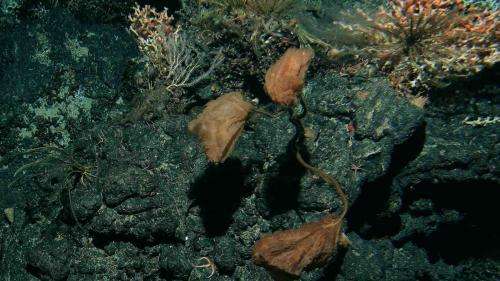Unique animal communities may need special protection

New Zealand's underwater mountains are home to unique animal communities which need careful environmental management, research from Victoria University of Wellington and the National Institute of Water & Atmospheric (NIWA) reveals.
The collaborative deep-sea study discovered that the hydrothermal activity of these mountains—known as seamounts—helps to create unique sets of biological communities.
PhD student Rachel Boschen, working under the supervision of Professor Jonathan Gardner from Victoria's School of Biological Sciences and Dr Ashley Rowden and Dr Malcolm Clark from NIWA, says seamounts generate special minerals due to their location near tectonic plates.
"Cold water filters through the seabed, heats up and shoots out as hot acidic water. As this water cools, minerals containing gold, silver, copper and zinc form giant black chimneys on the sea floor. These chimneys collapse and reform, creating large mounds of metal-rich mineral deposits."
hese mineral deposits are hugely valuable, not only for mining but also to deep-sea species, says Rachel.
"Some of the chemicals, such as hydrogen sulfide and methane, support communities that exist without sunlight, instead relying on bacteria that metabolise chemicals from the hot water. Animals in such communities can't survive away from the sites that supply these chemicals."
The research team studied three seamounts along the Kermadec volcanic arc, each with different levels of hydrothermal activity. By towing a video camera at depth from a ship and using an echo sounder, they were able to gather data on local ecologies as well as the environment and terrain.
"We found that each seamount has unique groups of animals", says Rachel, "depth and seabed terrain helped explain differences in communities but the most important driver was hydrothermal activity."
The study, published yesterday as a featured journal article in Marine Ecology: Progress Series may have implications for the mining of these areas.
"To carry out seabed mining you must have protected 'set-aside' areas to conserve ecologically important parts of the seabed," says Rachel. "But because each seamount contains unique communities, you may need to have a number of set-aside areas distributed over multiple seamounts to protect all of them."
The results also suggest seamounts with low hydrothermal activity may support communities not found elsewhere within the region.
"Previously it was thought the protection of communities at sites where hydrothermal activity was low or had ceased was of less concern," says Rachel. "But the groups of animals at these sites don't exist elsewhere, suggesting they need to be protected as well."
More information:
"Megabenthic assemblage structure on three New Zealand seamounts: Implications for seafloor
massive sulfide." miningwww.int-res.com/articles/feature/m523p001.pdf
Journal information: Marine Ecology Progress Series
Provided by Victoria University





















